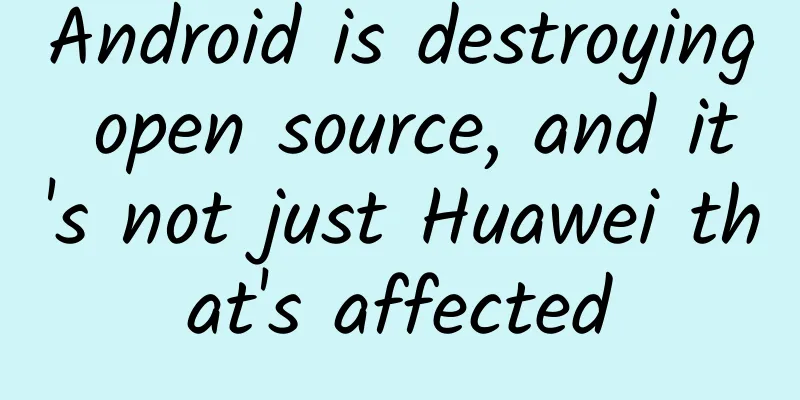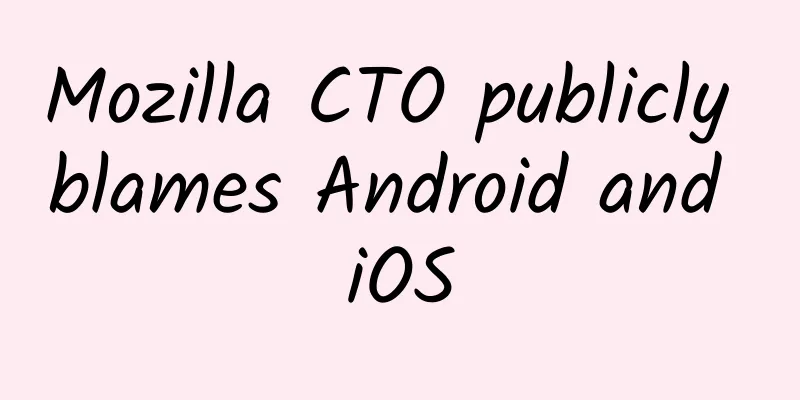Android is destroying open source, and it's not just Huawei that's affected

|
Not long ago, Huawei's consumer business CEO Yu Chengdong publicly stated that Huawei's mobile phones are running out of chips. Recently, the United States has "blacklisted" 38 of Huawei's subsidiaries in an effort to cut off Huawei's channels for purchasing chips from outside. In addition to hardware, Huawei is also facing "Android supply cuts" again at the software level. After Huawei was included in the "Entity List" by the United States last year, it could no longer use a series of Google services and applications. Although the temporary general license has been extended several times since then, it also expired this month.
In fact, "Android supply cut" is not an accurate statement. Because the Android system is open source, the US government has no right to interfere, but Huawei will still be affected by Google's restrictions.
This is because Google has been hollowing out the open source part of Android for many years, causing the world's largest mobile operating system to move step by step from open source to closed source. Therefore, Huawei is not the only manufacturer affected. Android: open source shell, closed source coreThis is another story about a dragon slayer who turned into a dragon. In 2007, two things happened that brought smartphones into a new era. One was the release of the iPhone by Apple, and the other was the birth of Android. Unlike iOS, the Android system partially uses the LInux kernel, and Google also licenses Android to all manufacturers in an open source manner.
Google's move is actually to counter the closed-source iOS system. It uses the open source system to quickly expand the scale of Android. Moreover, most of Android's APIs also support the iOS system, which is very attractive to developers. Andy Rubin, the "Father of Android", said at the time: If Google does nothing, we will have to accept a very scary future, a world without choice: the same person, one company, one phone, one operator. Thanks to the open source strategy, in 2010 the market share of the Android system has surpassed Nokia's Symbian system, which has dominated the mobile phone market for more than ten years, and has become the world's largest smartphone operating system. But at this point, Android's open source is no longer an engine driving growth for Google, but instead has become a risk that cannot be ignored. Because of Android's open source license, other manufacturers can develop a new system based on Android's source code to replace Android. Such examples are not uncommon in the open source world. In addition, if Android follows the GPL license of the Linux kernel, it means that all modifications to the source code must be open source, which will force hardware manufacturers using Android to disclose the source code of hardware drivers and applications, which is equivalent to asking them to make their core technology public. So Google adopted another open source license ASL to bypass this problem, because the ASL license stipulates that third parties can use the source code at will without having to open source it. Because of this, Greg Kroah-Hartman, the project maintainer of the Linux kernel, announced in 2010 that the Android code would be removed from the Linux kernel code base, and hinted that Android was not truly open source. And this was just the beginning of Android's closed-source journey, after which Google gradually split Android into two parts. One part is the Android Open Source Project (AOSP), which provides the basic framework code of Android. All manufacturers can obtain the above open source code for free. The other part is Google Mobile Services (GMS), which includes a series of applications and APIs including the "Google Three-Piece Suite", and GMS is closed source.
If a mobile phone manufacturer wants to use GMS, in addition to passing Google's hardware compatibility test, each mobile phone must also pay Google a licensing fee of US$0.75. The question is, why do manufacturers not use the free and open source AOSP and accept the GMS with many restrictions? The answer given by Google is to make AOSP less and less user-friendly and make manufacturers increasingly dependent on GMS. Although AOSP does not belong to Google alone and no one can remove an open source system from the shelves, Google can stop updating a large number of applications and APIs in AOSP and transfer the upgraded versions to the closed-source GMS.
From search, music to text messaging and other applications, Google has gradually hollowed out the applications and APIs in AOSP and replaced them with applications and APIs in GMS. The old versions of applications and APIs in AOSP are no longer upgraded, and after several versions, they have gradually become useless. In this way, although AOSP is still open source, only a bottom-level shell remains, and the competitive core parts are all in GMS. Google can also firmly control Android with its monopoly functions and maintain its influence on hardware manufacturers and developers. The essence of Android is as described in this article: Originally, everyone thought that Android was the Linux of the mobile phone industry, but in fact it is a Windows that allows everyone to view the code, allows some people to modify branch codes, and only Google itself can modify the main line code. Is it really okay if I can’t use the full version of Android? As mentioned above, only when AOSP and GMS are used together can it be a complete version of Android. What will happen if a castrated version of Android is used? For mobile phone manufacturers, this means a decline in product competitiveness. Just like if the iPhone cannot use WeChat, its sales in China will be greatly affected. In Europe and the United States, if the mobile phone does not support applications such as YouTube, Gmail, Google maps, etc., most consumers will also not accept it.
Due to the suspension of supply of Google GMS Android system, Huawei's consumer business, which mainly relies on mobile phones, does have loopholes. Of course, for most Chinese users, they have long been accustomed to the Android system without Google services. There are alternatives to the “Google family bucket” in China, but won’t our user experience be affected by the lack of GMS? Obviously not. For a long time, domestic Android phones have been criticized for lag and severe overheating, and a large part of the reason is that they cannot use the GMS message push service. Both iOS and native Android systems have a system-specific message push service. Third-party software can push messages to users without being started. Applications do not need to run in the background for a long time, making the system smoother.
The result is that it is prone to lag and battery consumption is fast, which is why some domestic mobile phones with increased RAM to 8GB may not be as smooth as foreign Android phones with 4GB RAM. In order to solve this problem, the Ministry of Industry and Information Technology took the lead in establishing the Unified Push Alliance in 2017 to establish unified standards for domestic Android message push services. Mainstream Android phone manufacturers such as Huawei, Xiaomi, OPPO, vivo, and Samsung have joined and gradually completed the adaptation. Some time ago, the Unified Push Alliance tested the system-level unified push channel on OPPO Find X2 Pro, and the results showed that the phone’s standby time was increased by up to 43%. Although the unified push standard in China has not yet been fully popularized and the experience is still somewhat different from the native Android system, the experience of the domestic Android ecosystem may indeed be greatly improved in the future. Huawei is not the only one fighting against Android's closed source In order to cope with the crisis of Android supply interruption, Huawei launched Huawei Mobile Services (HMS) to replace GMS. Yu Chengdong also said that Hongmeng can be used on mobile phones at any time and the migration can be completed in one or two days. In addition to Huawei, some manufacturers have tried to bypass the Android system which is firmly controlled by Google in the past. Although Amazon's Kindle Fire still uses the Android framework, it has also launched a set of services and applications to replace GMS, equipped with its own app store, browser, and cloud storage applications.
In addition, OEM manufacturers that cooperate with Google cannot produce devices that are not compatible with Android versions, otherwise Google has the right to revoke the manufacturer's license to produce any Android devices. In 2012, when Acer was working with Alibaba to release a smartphone running Alibaba Cloud OS, it received a warning from Google, saying that if Acer used Alibaba Cloud OS, Google would terminate its cooperation and technical authorization in Android products, and the launch conference was eventually cancelled.
This can be seen from the Tizen operating system jointly developed by Samsung and Intel. Tizen was originally expected by Samsung to "dominate the high-end mobile phone market", but it has been difficult to attract developers to develop applications for this ecosystem. Now Tizen mainly runs on Samsung's low-priced models in emerging markets, as well as smart watches, smart TVs and other devices.
Open source has changed the Internet and will continue to do so In 1985, Richard Stallman, a programmer at the MIT Artificial Intelligence Laboratory, proposed the concept of free software, aiming to develop a set of operating systems and compilers GCC, whose source code could be freely used. Famous open source tools were created by Richard Stallman.
The open source movement is of great significance to the Internet. As Huo Ju said, without the open source movement, there might be no Linux, Android, browsers... the entire Internet might not exist. The open source movement can be regarded as one of the greatest miracles in human history. People from all over the world, in different countries and under different systems, using different languages, have jointly created a bunch of tools that belong to all mankind and are free for everyone to use. But the freedom of open source is being eroded bit by bit today. In addition to Android becoming closed source, GitHub, the world's largest open source code hosting platform, also began to ban developer accounts in some countries and regions last year to comply with US trade sanctions.
A few days ago, the Ministry of Industry and Information Technology announced that it had chosen Gitee to build an "independent, open source hosting platform for China." Although the open source world has encountered challenges, open source software was born to break various shackles and restrictions. Today, large technology companies, whether Apple, Google, Tencent, Alibaba, or Huawei, have established a large number of open source projects.
Open source can verify the quality of the model, and AI giants can also quickly occupy the market and take the lead through open source. Just like Android back then, Google is now gradually building influence in the field of AI through the open source software library TensorFlow. Xiaomi's Cloud-ML platform is an architecture product built on open source platforms such as TensorFlow. In China, where the open source ecosystem is not yet mature, it is still unknown whether a world-class large-scale open source project like Android can be born, but this will undoubtedly be a goal that Chinese developers will strive for. |
<<: Keep your apps away from jailbreak: iOS 14 App Attest protection feature
Recommend
Kuaishou short video product analysis!
Short videos have become a part of our daily live...
5 formulas you must master to operate e-commerce well
With the rapid development of e-commerce, more an...
How to make users addicted to your product? 5 steps!
"Information overload" is the current s...
Weekly Science and Technology Award|Promising Photocatalytic Materials
In 1972, "Nature" published a paper pro...
WeChat has been updated! New features include message notification tone, pinning, chat folding, etc.
[[411252]] As a national-level application, every...
Why can't I hear people clearly when I take off my glasses?
People with myopia often feel that after taking o...
The Android system is becoming more and more mature, are you still using third-party ROMs?
The term "flashing" has almost no statu...
Shrimp or "monkey" is actually a "little bug" with strong survival ability.
Artemia, also known as Artemia, Artemia shrimp, a...
Why do I recommend that you really dry your quilt regularly?
Among all animal phobias, spider phobia is defini...
Beauty industry hot-selling course: Beauty industry account formula
Course Catalog ├──01、The beauty industry IP I inc...
Wild animals frequently "enter cities", and it is urgent to build a new model of scientific coexistence
This year, Siberian tigers have invaded villages,...
The dumb way to promote App online, the qualitative change from 0 to 1 million users
There are some stupid ways to promote apps online...
MBP battery life collapses: Why does Apple resort to such tricks to cover up its shame?
Every system update is exciting, after all, every...
The food you think is "dirty" is actually rich in nutrients
Duck blood is a very common food ingredient, smoo...









